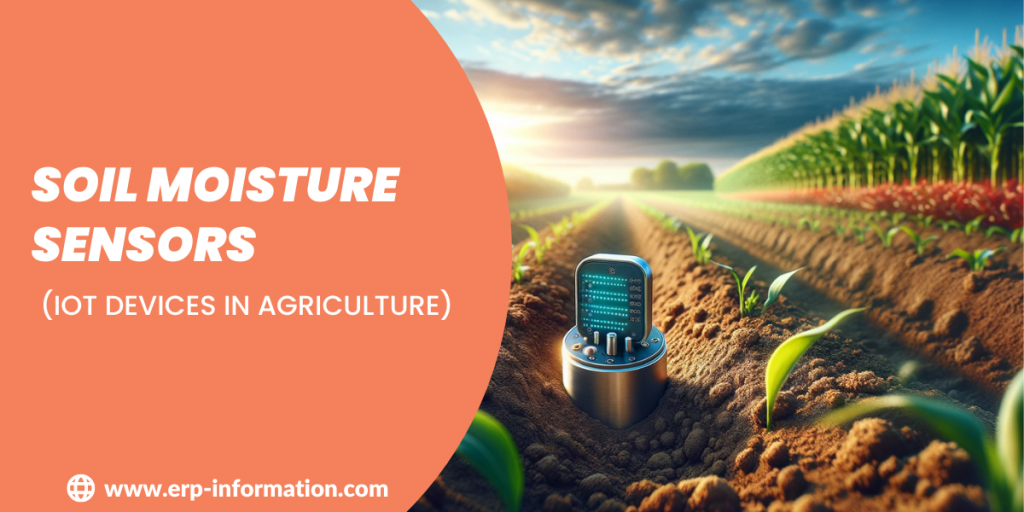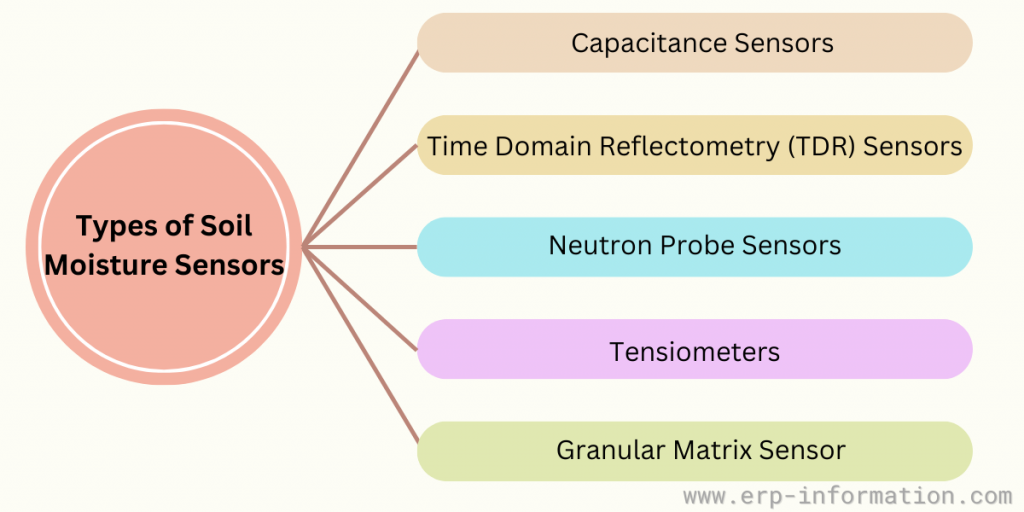Simply imagine a world where plants tell us exactly what they need to thrive. Yes, now it is possible because of soil moisture sensors. They are unsung heroes revolutionizing how we understand our gardens and farms.
These tiny devices offer a peek into the secret language of soil, helping us decipher when and how much water our plants truly crave.
In this blog post, we’ll delve into the magic of these sensors, uncovering their types, pros, cons, and how they work.
Types of soil moisture sensors
There are 2 types of soil moisture sensors. Let us discuss both types in detail with their work, pros, cons, and examples.
1. Sensors that measure volumetric water content
Capacitance Sensors
Capacitance sensors determine soil moisture by measuring changes in electrical capacitance between two electrodes in contact with the soil. They are often used in precision agriculture and landscaping.
Working
The sensor consists of at least two electrodes, typically embedded in or near the soil. One electrode acts as a transmitting (or measuring) electrode, while the other acts as a receiving (or ground) electrode. An electrical field is established between these electrodes.
A capacitor contains two conductive plates separated by a non-conductive material or dielectric. In the case of soil moisture sensors, the soil between the electrodes acts as the dielectric material.
When the soil is dry, it has a lower dielectric constant (εr) similar to air. But as moisture increases in the soil, the dielectric constant also rises, altering the capacitance between the electrodes.
The increase in capacitance is translated into an electrical signal, which is then processed by the electronics of the sensor.
This processed signal is further conditioned and interpreted.
Depending on the design and programming, the sensor might convert these changes into readable data, such as percentage moisture content, or trigger actions like providing an output voltage or activating a display indicating soil moisture.
Pros
- High sensitivity
- Fast response time
- Highly accurate with proper calibration
- Less expensive compared to TDR
- Low power consumption
- Less sensitive to drift
Cons
- Able to sense small area
- Easily impactable by soil condition
- Specific calibration needed
Examples
Teros 12 Soil Moisture Sensor by METER Group, Spectrum SMEC300, Spectrum SM100, Sentek Enviroscan, Diviner 2000
Time Domain Reflectometry (TDR) Sensors
TDR sensors send electromagnetic pulses into the soil and measure the time it takes for the pulse to reflect back. The travel time is related to soil moisture content. These sensors are known for their accuracy and are suitable for research and precision agriculture.
Working
Time Domain Reflectometry (TDR) sensor works on the principle of radar based on transmitting signals into the medium and collecting reflected signals.
It sends signals into the earth and listens intently for whispers bouncing back.
TDR accurately assesses the medium’s dielectric constant and transmits signals through two metal probes buried in the soil, it awaits the return of these signals, analyzing their every variation.
These probes, typically 10–30 cm long, establish a connection to the TDR through a coaxial cable. Analyzing the returned signals, especially their magnitude, shape, and sign, TDR provides a complete view of the transmitting medium.
Pros
- It is very accurate
- No need to do soil calibration
- Provides remote access
Cons
- It is able to consider a very small area
- It is expensive
Examples
Acclima true TDR 315, 315L, 310 S; Spectrum Field Scout TDR; CS 655, 650 tec
Neutron Probe Sensors
Neutron probe sensors use neutron radiation to measure soil moisture indirectly. They are highly accurate but typically require trained personnel and are used in research and large-scale agriculture.
Working
The neutron method of measuring soil moisture operates based on this principle: as a source emits fast neutrons into the soil, they’re slowed and scattered by the soil itself.
This action creates a cloud of slow neutrons enveloping the probe.
However, this neutron cloud doesn’t endlessly increase in density; it stabilizes at an equilibrium influenced by how quickly neutrons are absorbed into the soil.
In dry soil, the neutron cloud is less dense and reaches farther from the probe. Conversely, in wet soil, the neutron cloud is denser and spans a shorter distance from the probe.
Pros
- It is very accurate
- Able to measure a large area
- Is not affected by salinity and air gaps around the access tube
Cons
- Soil-specific calibration needed
- It is very expensive and heavy
- Need to have the license
- Not accurate at slight depths
- No remote access
Examples
CPN-Instrotek; Troxller
2. Sensors that measure soil tension when placed in the soil profile
Tensiometers
Tensiometers measure soil moisture tension, which is the force needed to extract water from the soil. They are used to monitor water availability to plant roots and are often employed in research and horticulture.
Working
Tensiometers gauge soil moisture using units of negative pressure, which means tension. It measures the force necessary for plant roots to draw water from soil pores.
Water held in larger pores (macropores) requires less force compared to that in smaller pores (micropores).
When plants extract moisture, it starts from the largest pores. As the soil dries, increased force is needed to extract water from smaller pores.
High tension values indicate the soil is dry, and less tension values indicate the soil is moist.
Pros
- Works without electricity
- Not expensive
- You will get it in different lengths
- Salinity does not affect it
Cons
- The operative range is small
- The response time is slow
- Maintenance needed more often
- No remote access – manual data collections
Example
Irrometer tensiometers
Granular Matrix Sensor
A granular matrix sensor, also known as a granular matrix or granular soil moisture sensor, utilizes a matrix of granules or particles to measure soil moisture content. This sensor consists of a porous matrix or material that is sensitive to changes in moisture levels.
Working
A Granular Matrix Sensor for electronically gauging soil moisture, known as the Watermark soil moisture sensor by Irrometer Co. in Riverside, CA, has been patented.
This sensor technology addresses issues found in gypsum blocks such as dissolving and inconsistent pore size distribution by utilizing a confined granular matrix within a metal case.
Functioning on the principle of electrical resistance similar to gypsum blocks, granular matrix sensors feature a gypsum wafer embedded in the matrix.
Electrodes within the sensor are positioned in the granular fill material above the gypsum wafer.
The gradual dissolution of the gypsum wafer serves to moderate the impact of soil solution salinity on the electrical resistance between the electrodes.
According to Larson (1985), the particle size and compression of the granular fill material determine the pore size distribution in these sensors, impacting their response characteristics.
Pros
- Accuracy level is good in medium soils
- Less expensive
- Measures moisture content continuously in the same area
Cons
- Response time is more
- Accuracy is less in sandy soils
- It is very sensitive to temperature and salinity
Example
Irrometer watermark sensors
FAQs
How do soil moisture sensors benefit farmers?
Soil moisture sensors provide real-time data on soil moisture levels, enabling farmers to optimize irrigation schedules, prevent overwatering or underwatering, and enhance crop health and yield.
Can soil moisture sensors be integrated with existing irrigation systems?
Yes, soil moisture sensors can be integrated with existing irrigation systems. By connecting sensors to controllers, farmers can automate irrigation processes based on real-time soil moisture data, resulting in efficient water usage and improved crop growth.
Conclusion
Many types of soil moisture sensors are available. You can choose the suitable soil moisture sensors depending on your budget, soil types, and requirements.

